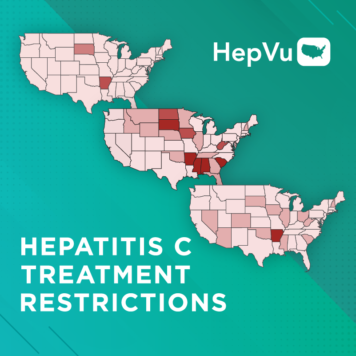Dr. John W. Ward is the Director of the Coalition for Global Hepatitis Elimination (CGHE). Previously, he served as the Director of the Division of Viral Hepatitis at the Centers for Disease Control and Prevention (CDC).
Q: You spoke with HepVu in 2019 about the work the Coalition for Global Hepatitis Elimination (CGHE) is doing to help eliminate viral hepatitis. How has that work progressed over the past three years?
Since we launched in July 2019, the coalition’s activities have grown tremendously. And it’s grown despite the time and attention that the COVID-19 pandemic required. Because of the COVID-19 pandemic, we had to shift our support for viral hepatitis elimination activities from hands-on to distance-based strategies, while still scaling up technical assistance to help countries and local partners achieve goals for viral hepatitis elimination.
One of the key areas that grew significantly was our distance-based learning. We convened a series of webinars on different topics including Hepatitis B birth dose implementation in Africa, viral hepatitis testing, linkage to care, and how to develop and support viral hepatitis elimination programs. We also had a series of viral hepatitis-related webinars that we convened in collaboration with the National Institutes of Health (NIH).
We had over 3,000 registrants from over 90 countries participating in those educational activities and they all benefitted from learning from one another in a true peer-to-peer spirit of collaboration. We also brought together some of the world’s leading experts in viral hepatitis elimination.
I became very, very committed to democratizing access to information that can help people begin and successfully develop viral hepatitis elimination programs, as well as helping programs learn without the barriers, like paywalls for medical journals or the cost of attending medical conferences. Making information available broadly was a great advance that came from the response to COVID-19, and one that I hope that we will continue in the future as we move from pandemic response to pandemic recovery.
We also launched our country dashboards, which bring together credible information for over 190 countries. In that way, we are very much like HepVu, which is focused on the United States. The Coalition brings together credible information for countries around the world.
Taking that a step further, we’re developing in-depth National Hepatitis Elimination Profiles, or what we call N-HEPs. In addition to data on the burden of Hepatitis B or Hepatitis C and various aspects of each program, we work with ministries of health, expert clinicians, civil society organizations, and other local partners to really profile the plans, policies, programs, and partnerships that are in place and contribute to advances in progress toward viral hepatitis elimination. The local partners also raise awareness of the remaining challenges and feasible next steps the country can now take to advance progress toward viral hepatitis elimination.
We have created these profiles for ten countries already, including the United States, and we’re on track to have about 40 by the end of this year. I think we are providing information in an original way that can better inform partners in countries around the world about viral hepatitis elimination and promote action, because of those feasible next steps being identified.
Q: The CGHE recently published its 2021 Annual Report. The report mentions several ongoing information-sharing programs, including one that profiles the status of different viral hepatitis elimination plans. Can you tell us more about how the National Hepatitis Elimination Profiles might advance global progress towards viral hepatitis elimination?
I think they do that in several ways. Number one, they provide a reason for key stakeholders to work together if they’re not already doing so. This is because we seek the input of the Ministry of Health on the state of affairs regarding the burden of disease and the status of governmental programs. We also consult expert clinicians regarding how care is really delivered and any successes or challenges in that regard.
We also involve civil society organizations so we can understand societal attitudes that bear on elimination efforts, stigma, and marginalization, as well as lack of access for key populations. By getting these groups literally on the same page, we feel like that provides a great environment for them to continue to work together—and to act on those feasible next steps.
In addition, we are bringing information together that’s not being brought together currently. It is important to raise awareness in a way that is positive by acknowledging successes that can be balanced against the challenges so that it’s as well-received as possible. This helps to build coalitions that can promote action at the national level.
Q: Certainly, one of the biggest changes in the public health landscape over the past few years has been the COVID-19 pandemic. CGHE conducted a study on the impact of COVID-19 on Hepatitis B and Hepatitis C treatment that was published in Clinical Liver Disease. Based on that work, how do you think the pandemic has impacted viral hepatitis prevention, care, and treatment?
Like most other parts of healthcare, the COVID-19 pandemic—particularly in the early months—adversely impacted viral hepatitis vaccination, testing, and treatment. There were large declines in infant immunization around the world. There were estimations of declines in Hepatitis B vaccination of newborns.
So, there were clearly adverse consequences for viral hepatitis prevention and treatment stemming from social distancing recommendations, anxieties about coming in contact with large crowds including in health care, and from the redirection of healthcare staff and facilities to respond to COVID-19. Although not yet to pre-COVID-19 levels at the time the survey concluded, what we did find in the Coaltion survey of respondents from 40 countires is that over time hepatitis vaccination, testing, and treatment began to rebound. Service delivery appears to be headed in a good direction, indicating that the health systems are developing telehealth and other strategies to deliver services during the response to COVID-19.
On a positive note, despite the clear adverse consequences of the COVID-19 response, countries continued to launch viral hepatitis elimination initiatives. Mexico launched a very promising viral hepatitis elimination program, beginning with Hepatitis C testing and treatment in their HIV treatment programs and scaling that up to be available in every state in the country. Rwanda continued to make great progress in its Hepatitis C elimination program. India launched a national viral hepatitis plan. And China has one that will most likely be released this year. Although we clearly had steps back in progress toward hepatitis elimination, we also had some steps forward.
Q: Going back to the N-HEP profiles for a little bit, based on CGHE’s evaluation of programs around the world, how does the U.S.’s viral hepatitis elimination efforts compare to other industrialized nations?
That’s a very good question. I think we are doing well in many respects. We do have a national plan that has elimination targets that came out in 2020. So that is quite good. We have an all-adult Hepatitis C testing policy that is a no co-pay preventive service. That is a step ahead of many industrialized countries. We should be very mindful of that leadership and really seek to put that policy into practice and get more and more people tested.
In addition, the prices of drugs have fallen dramatically to where they are a cost-saving intervention here in the United States. So that’s also a welcome advance. That said, obviously, we have some work to do. We need much more effective harm reduction access for people who inject drugs. We are far behind other industrialized countries in that area. The combination of access to sterile injection equipment, drug treatment, and Hepatitis C testing and treatment can prevent over 90% of new Hepatitis C infections among persons who inject drugs. With the increasing rates of Hepatitis C infections related to the opioid epidemic, the country needs a large increase in access to these services immediately.
The one area where we can do better is ensuring access to Hepatitis C medications. Currently some states require prior authorization for insurance, or specialist care, or deny coverage because of concerns regarding the patient, etc. Being cured of Hepatitis C decreases the risk of death from liver disease by 80%. We must do better to knock all those barriers down so that all persons with Hepatitis C are screened, diagnosed, treated, and cured of their infection. In summary, by the progress to date and by taking these two steps to prevent unsafe injections during drug use, and to increase access to Hepatitis C testing and treatment, the United States can eliminate Hepatitis C.




